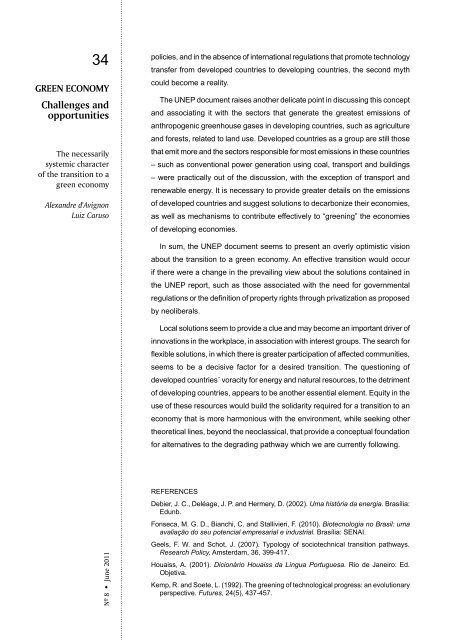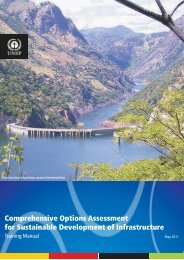Download Publication - Rio+20
Download Publication - Rio+20
Download Publication - Rio+20
Create successful ePaper yourself
Turn your PDF publications into a flip-book with our unique Google optimized e-Paper software.
34<br />
GREEN ECONOMY<br />
Challenges and<br />
opportunities<br />
The necessarily<br />
systemic character<br />
of the transition to a<br />
green economy<br />
Alexandre d'Avignon<br />
Luiz Caruso<br />
policies, and in the absence of international regulations that promote technology<br />
transfer from developed countries to developing countries, the second myth<br />
could become a reality.<br />
The UNEP document raises another delicate point in discussing this concept<br />
and associating it with the sectors that generate the greatest emissions of<br />
anthropogenic greenhouse gases in developing countries, such as agriculture<br />
and forests, related to land use. Developed countries as a group are still those<br />
that emit more and the sectors responsible for most emissions in these countries<br />
– such as conventional power generation using coal, transport and buildings<br />
– were practically out of the discussion, with the exception of transport and<br />
renewable energy. It is necessary to provide greater details on the emissions<br />
of developed countries and suggest solutions to decarbonize their economies,<br />
as well as mechanisms to contribute effectively to “greening” the economies<br />
of developing economies.<br />
In sum, the UNEP document seems to present an overly optimistic vision<br />
about the transition to a green economy. An effective transition would occur<br />
if there were a change in the prevailing view about the solutions contained in<br />
the UNEP report, such as those associated with the need for governmental<br />
regulations or the definition of property rights through privatization as proposed<br />
by neoliberals.<br />
Local solutions seem to provide a clue and may become an important driver of<br />
innovations in the workplace, in association with interest groups. The search for<br />
flexible solutions, in which there is greater participation of affected communities,<br />
seems to be a decisive factor for a desired transition. The questioning of<br />
developed countries´ voracity for energy and natural resources, to the detriment<br />
of developing countries, appears to be another essential element. Equity in the<br />
use of these resources would build the solidarity required for a transition to an<br />
economy that is more harmonious with the environment, while seeking other<br />
theoretical lines, beyond the neoclassical, that provide a conceptual foundation<br />
for alternatives to the degrading pathway which we are currently following.<br />
Nº 8 • June 2011<br />
References<br />
Debier, J. C., Deléage, J. P. and Hermery, D. (2002). Uma história da energia. Brasília:<br />
Edunb.<br />
Fonseca, M. G. D., Bianchi, C. and Stallivieri, F. (2010). Biotecnologia no Brasil: uma<br />
avaliação do seu potencial empresarial e industrial. Brasília: SENAI.<br />
Geels, F. W. and Schot, J. (2007). Typology of sociotechnical transition pathways.<br />
Research Policy, Amsterdam, 36, 399-417.<br />
Houaiss, A. (2001). Dicionário Houaiss da Língua Portuguesa. Rio de Janeiro: Ed.<br />
Objetiva.<br />
Kemp, R. and Soete, L. (1992). The greening of technological progress: an evolutionary<br />
perspective. Futures, 24(5), 437-457.

















